The Forres (River Findhorn & Pilmuir) Flood Alleviation Scheme, completed in 2014, has to date prevented flooding of over 700 properties at an estimated saving of approx. £27 million. MeasurIT Technologies are proud that our Tideflex valves form part of this important project.
Project details
Client: The Moray Council
Consulting Engineer: Royal HaskoningDHV
Contractor: Morrison Construction
Design details: 3No. 900mm Tideflex S35-1 Valves - flanged, flared rubber duckbill valves
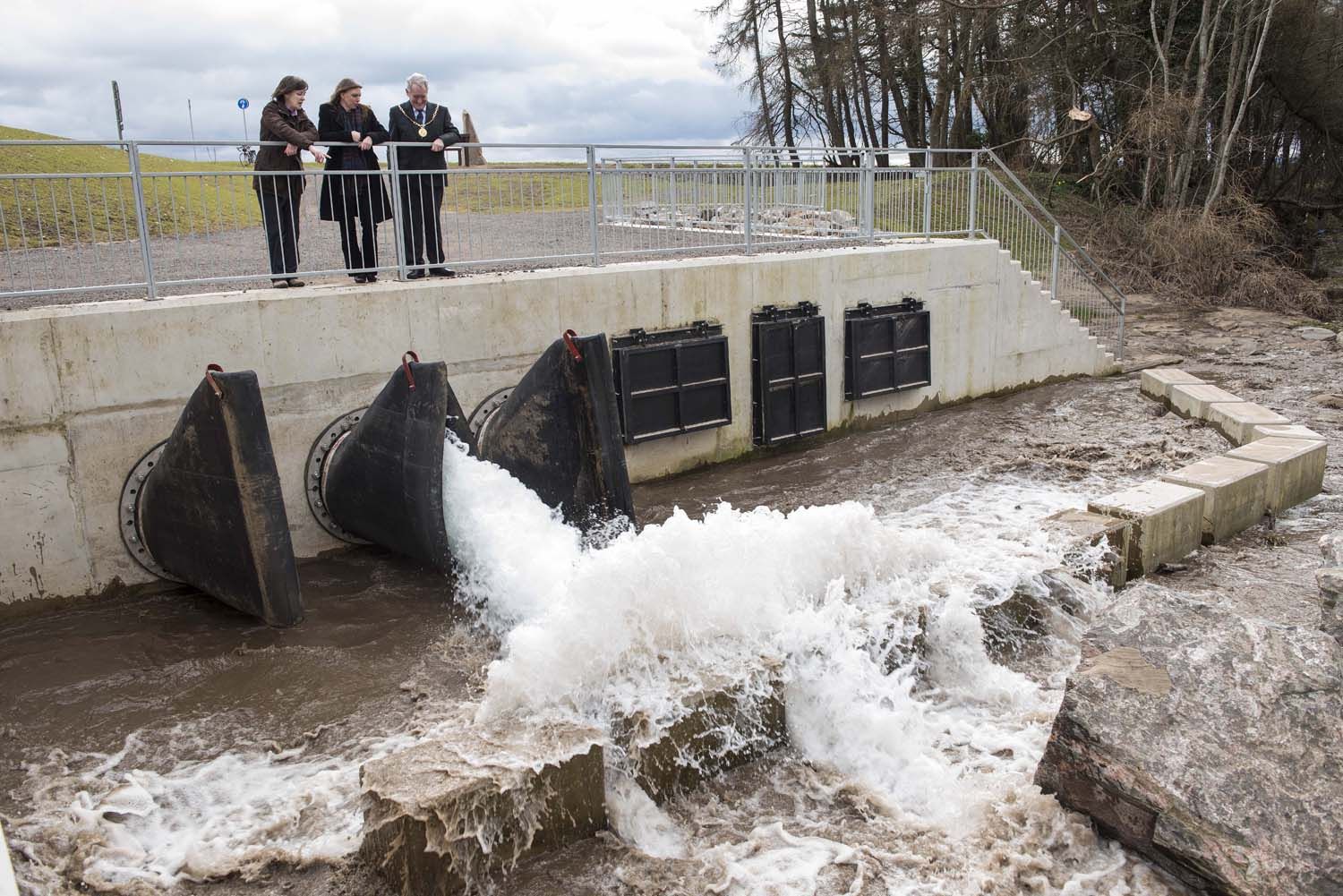
General Background
The town of Forres on the Moray coast in Scotland lies within the floodplain of the Findhorn River and thus it has always been prone to flooding by both the river and the Burn of Mosset. The Pilmuir area on the western edge of the town has also suffered due to poor drainage and a high water table, which has meant that ground and surface water has struggled to drain away from the area. The town has seen significant growth in recent years and now has over 12000 inhabitants, which meant that the impact of flooding had increased in severity, both in number of lives affected and cost of damages and related effects. In fact, Forres was one of a number of communities in Moray affected by devastating floods in the 1990s and 2000s. The response of the Moray Council to these events was to form an integrated, multi-disciplinary team of experts to undertake the Moray Flood Alleviation project - one of the largest of its kind in the UK - spanning 15 years and 4 towns and representing an investment of £180 million by the council in the area.
To better understand the impact of the flooding on the town, below are stills from the hydraulic model used to assess the extent of flooding during different storm events.
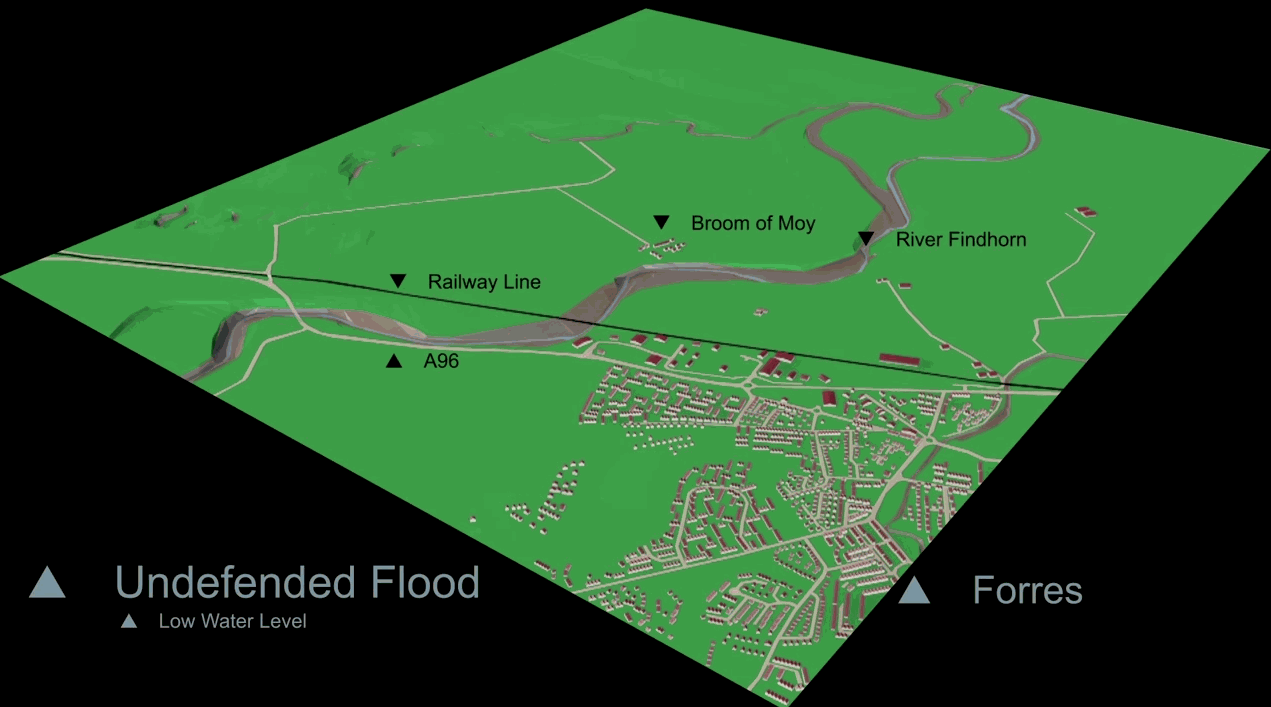
Undefended - Low Water
Forres during normal average rainfall events.
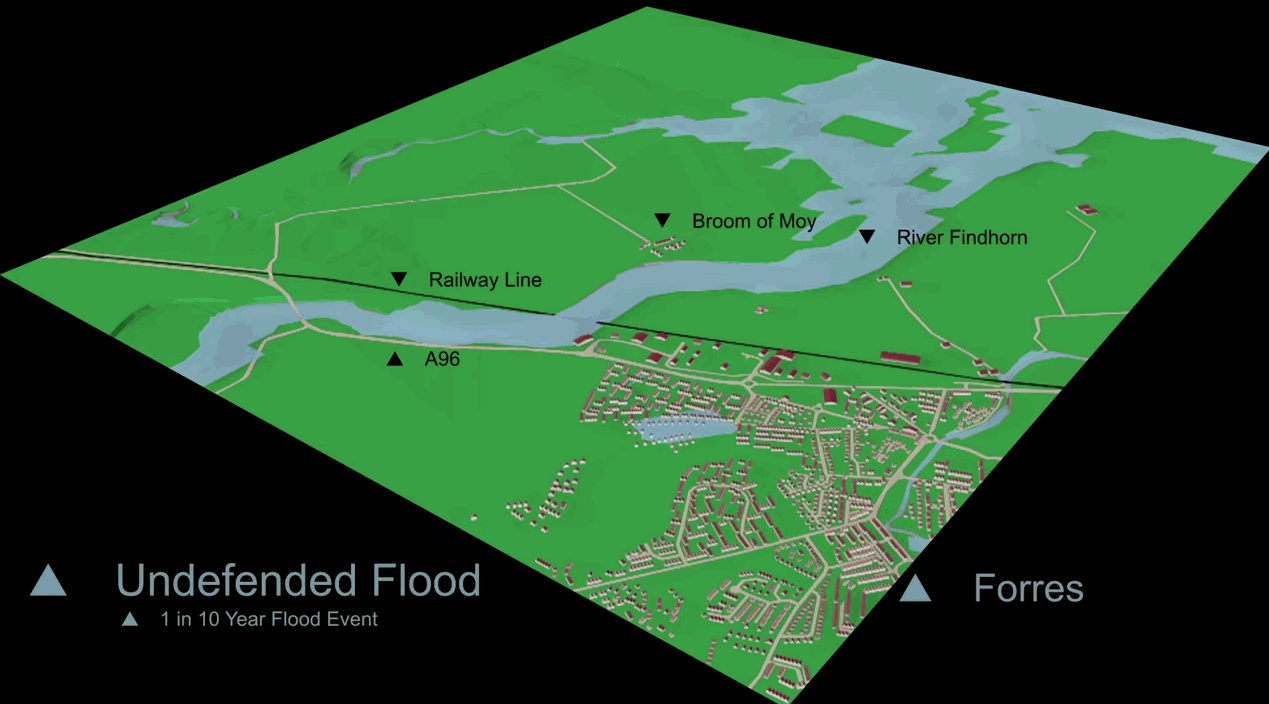
Undefended - 1 in 10 Year Flood Event
10% chance of this rainfall event in any given year.
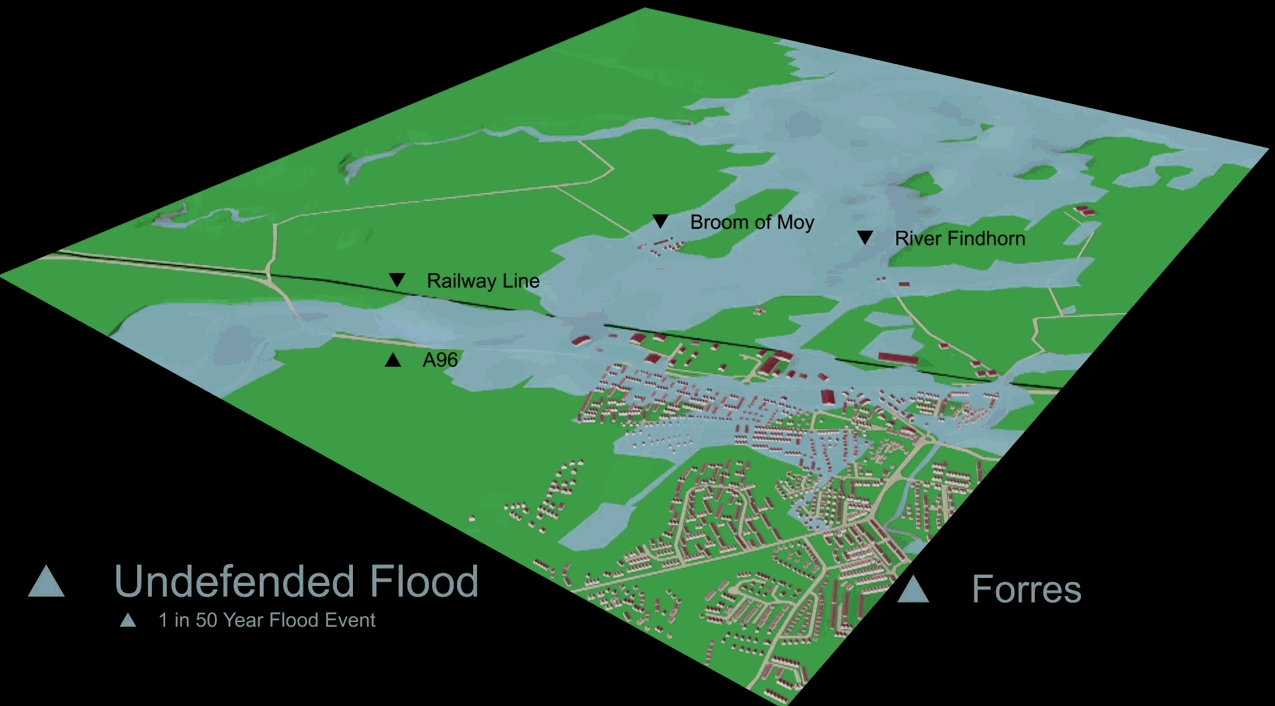
Undefended - 1 in 50 Year Flood Event
2% chance of this storm in any given year.
The proposed solution for Forres was two-fold - a dam on the Mosset Burn to restrict the peak flow of water passing through Forres during flood events, and the increase of floodplain capacity of the River Findhorn along with diversion of flood water by means of embankments and drainage channels. The dam scheme - Forres (Burn of Mosset) - was completed in 2009 and is designed to provide a 1 in 100 year level of protection, while the Forres (River Findhorn & Pilmuir) scheme, which is the focus of this case study, was completed in 2014 and is intended to provide a 1 in 200 year level of protection to the town.
On 11 August 2014 the partially completed Scheme was put to the test by a high rainfall event. It prevented proximately 650 residential units and 65 businesses from flooding at an estimated savings from damages of £27 million. The design team have every confidence that the fully operational scheme will provide flood protection for the 904 homes and 76 businesses of the town even during an extreme rainfall event, as illustrated in the image below.

Description of the Project
Part one of the scheme involved increasing the capacity of the Findhorn River to hold a greater volume of river water during high water events, and thus reduce the frequency and volume of water overspilling the river's banks. This was achieved by removing trees, undergrowth and soil in order to step back embankments and deepen the river bed along three of the river bends that pass by Forres to create more room for the water.

River bend before

River bend after
Part two of the scheme comprised the construction of new flood embankments between the river and parts of the town, and new drainage channels to direct water away from the Pilmuir area and into the river. Related to these were modifications to parts of the existing road network and the construction of the new Pilmuir pumping station.
The drainage channels serve to direct surface and groundwater from the Pilmuir area to the outfall on the river and operate under gravity during normal rainfall events. When river levels are high, during greater rainfall events, the flap valves on the outfall close to prevent water backing up along the drainage channels and flooding the Pilmuir area. In order to ensure that water can still be transported away from the area, the drainage channels are then emptied by pumping water from them into the river via the Tideflex duckbill valves also located at the outfall.
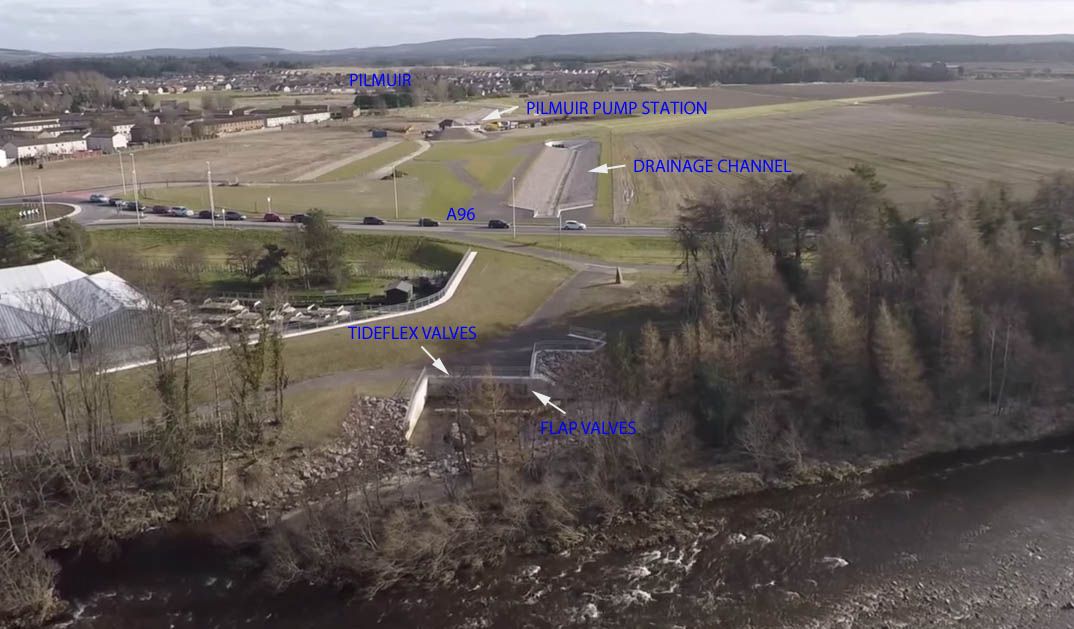
Contribution of Tideflex Valves to the Scheme
Obviously the success of the Pilmuir area part of the scheme rests on the unhindered operation of the valves at the outfall. The Tideflex valves must allow for channel water to exit to the river while themselves being submerged under the river water. They need to remain operational over many decades while withstanding weathering by the elements and possible obstruction by river-borne debris as the river returns to a more natural state over time.
Tideflex duckbill valves are self-clearing of debris and seal tight around obstructions, which makes them an excellent choice for use as an outfall valve on coast / beach outfalls, river outfalls, marine outfalls and in floodplains. Tideflex check valves are constructed out of reinforced rubber - a one-piece rubber matrix of numerous natural and synthetic elastomers and ply reinforcement, similar in construction to a truck tyre, that has specific hydraulic characteristics suited to their application on a given project. Therefore, there are no moving parts that can corrode, warp or freeze and the Tideflex valves will handle large obstructions without jamming or getting stuck in an open or closed position. This provides peace of mind for stormwater and combined sewer overflow systems designed to provide flood protection for low-lying areas.
The Tideflex check valve has an extremely low cracking pressure so the valve is self-draining which eliminates standing water and maximizes storage volume (attenuation) in the upstream drainage system. The increased bill height of the S35-1 means that the effective open area of the valve is greater and so reduces headloss and improves hydraulic performance compared to standard duckbill valves. This means that as long as the Pilmuir pump station provides a differential head across the valves of at least 1 inch, they will open enough to allow water to flow out into the river, even while submerged due to the high water levels. (Click here for a short video of Tideflex valves on a pumped discharge on another scheme in China.)
With over 30 years of design and research experience since their design of the original duckbill valve, Tideflex provides the track record for incorporation of their valves into a scheme of this significance. MeasurIT are confident that the valves will perform as intended over the course of their long lifespan and provide the residents of Pilmuir, Forres with peace of mind.
Contact us for more information on the use of Tideflex valves in pumped and gravity outfalls and a reference list of our involvement in large strategic projects.
MeasurIT would like to thank Royal HaskoningDHV and The Moray Council for access to the images of the scheme used in this case study. Further information and video footage of the scheme can be accessed on the council website here.
Tideflex used on Forres Flood Alleviation Scheme